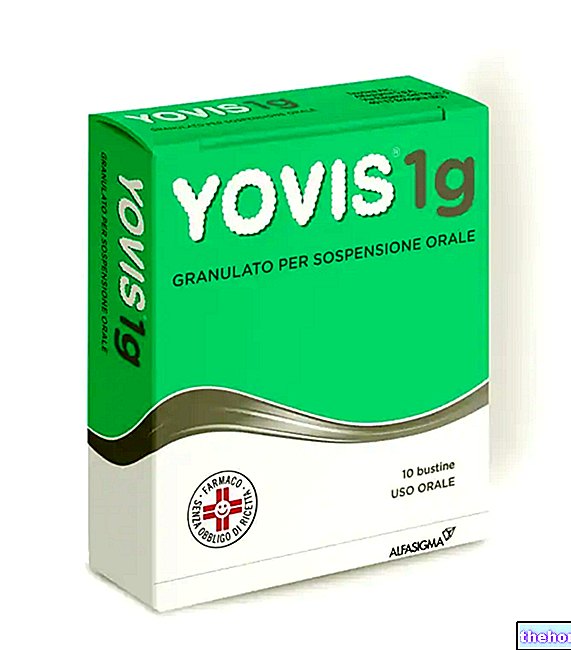Active ingredients: Desclorfeniramina (Desclorfeniramina maleate)
Polaramin 2 mg / 5 ml syrup
Polaramin package inserts are available for packs:- Polaramin 2 mg / 5 ml syrup
- Polaramin 1% cream
Why is Polaramin used? What is it for?
Polaramin syrup contains the active substance deschlorpheniramine maleate, which belongs to a class of medicines called 'antihistamines'.
Polaramin syrup helps reduce allergic symptoms by blocking the effects of a substance called "histamine" which is produced by the human body when you are allergic patients.
This medicine is used to treat the symptoms of diseases caused by seasonal pollen (such as rhinitis (stuffy nose, runny nose and itchy nose), conjunctivitis (red, burning and watery eyes), hives (itching and small spots on the skin), itching and vasomotor rhinitis (a form of non-allergic rhinitis).
Contact your doctor if you do not notice any improvement or if you notice worsening of your symptoms after a short period of treatment.
Contraindications When Polaramin should not be used
Do not take Polaramin syrup
- If you are allergic to deschlorpheniramine maleate, other similar antihistamines or any of the other ingredients of this medicine (listed in section 6).
- If you suffer from:
- glaucoma (high blood pressure inside the eye);
- prostatic hypertrophy (enlarged prostate);
- bladder neck obstruction (constricted bladder neck, causing difficulty urinating);
- pyloric and duodenal stenosis (narrowing of the outlet valve of the stomach and of the first section of the intestine);
- narrowing of other tracts of the gastrointestinal and urogenital tract;
- epilepsy (convulsions).
- For the treatment of lower respiratory tract diseases, including bronchial asthma.
- If you take monoamine oxidase inhibitors (so-called anti-MAO, medicines used to treat depression) at the same time or in the two weeks after stopping this treatment.
- If you are under the age of 12.
- If you are in the last three months of pregnancy (see "Pregnancy and breastfeeding").
Precautions for use What you need to know before taking Polaramin
Talk to your doctor or pharmacist before taking Polaramin syrup.
Polaramin syrup can cause excitability, especially in children (see "Possible Side Effects").
Stop using antihistamines (such as Polaramin syrup) about 48 hours before having skin tests, as antihistamine medicines can prevent or reduce positive reactions.
Only use this medicine after consulting your doctor if you have one or more of the following conditions:
- cardiovascular disease (of the heart and blood vessels),
- high blood pressure,
- hyperthyroidism (overactive thyroid gland),
- ocular hypertension (increased pressure in the eye).
Also consult your doctor if these problems have occurred in the past.
In elderly subjects the dose of Polaramin syrup will have to be determined by the doctor (see "Possible side effects).
Children and adolescents
This medicine should not be taken by children and young people under the age of 12.
Interactions Which drugs or foods can modify the effect of Polaramin
Tell your doctor or pharmacist if you are taking, have recently taken or might take any other medicines.
Do not take Polaramin syrup if you are on monoamine oxidase inhibitor therapy (so-called anti-MAO, medicines used to treat depression) or within two weeks after stopping this treatment, or if you are being treated with other antihistamines. , oral anticoagulants (medicines used to thin the blood), tricyclic antidepressants (a type of medicine used to treat depression), barbiturates (medicines used to treat epilepsy) or other central nervous system depressants (see "Do not take Polaramin syrup ").
If you are taking Polaramin, this may hide unwanted effects on the ear from antibiotics.
Polaramin syrup with food, drink and alcohol
Do not drink alcohol while taking Polaramin syrup.
Warnings It is important to know that:
Pregnancy and breastfeeding
If you are pregnant or breast-feeding, think you may be pregnant or are planning to have a baby, ask your doctor for advice before taking this medicine.
If you are pregnant (first six months) or breastfeeding, use Polaramin syrup only after consulting your doctor and evaluating the risk / benefit ratio with him.
Do not use the medicine in the last three months of pregnancy (see "Do not take Polaramin syrup") because newborns and premature babies can develop serious adverse reactions to antihistamines.
Driving and using machines
As the most common side effect of Polaramin syrup is sleepiness, do not drive cars or use dangerous machinery while taking the medicine.
Polaramin syrup contains sugar: take this into account if you have diabetes or are following a low-calorie (low-calorie) diet.
Polaramin syrup contains sucrose and sorbitol: if you have been told by your doctor that you have "intolerance to some sugars, contact your doctor before taking this medicine.
Polaramin syrup contains methyl parahydroxybenzoate and propyl parahydroxybenzoate which can cause allergic reactions (including delayed).
Polaramin syrup contains propylene glycol: it can cause symptoms similar to those caused by alcohol.
Polaramin syrup contains ethyl alcohol: for those who carry out sports activities, the use of medicines containing ethyl alcohol can determine positive doping tests in relation to the alcohol concentration limits indicated by some sports federations.
Dose, Method and Time of Administration How to use Polaramin: Posology
Always take this medicine exactly as described in this leaflet or as directed by your doctor or pharmacist. If in doubt, consult your doctor or pharmacist.
The recommended dose in adults and children over 12 years is 1 teaspoon (5 ml) 3-4 times a day.
Warning: do not exceed the indicated doses without the advice of your doctor. Use this medicine only for short periods of treatment.
Consult your doctor if the disorder occurs repeatedly or if you have noticed any recent changes in the characteristics of the disorder.
You can reduce stomach and intestinal side effects (anorexia, nausea, vomiting and diarrhea) by taking Polaramin syrup at mealtimes.
If you forget to take Polaramin syrup
Do not take a double dose to make up for a forgotten dose.
If you have any further questions on the use of this medicine, ask your doctor or pharmacist.
Overdose What to do if you have taken too much Polaramin
In case of accidental ingestion / intake of an excessive dose of Polaramin syrup, notify your doctor immediately or go to the nearest hospital.
You should use Polaramin syrup only at the recommended doses. Overdose can be very dangerous, especially in children.
If you take an excessive dose, you may see sedation (sleepiness), apnea (stop breathing), cyanosis (bluish discoloration of the skin and mucous membranes), decreased consciousness, arrhythmias (irregular heartbeat), cardio-circulatory collapse (drop in blood pressure blood), insomnia, hallucinations, tremors or convulsions, even death. Dizziness, tinnitus (ringing or ringing in the ears), difficulty moving, blurred vision and hypotension (low blood pressure) may also be present. In children it is more common to observe excitement, dry mouth, fixed and dilated pupil, hot flashes, rise in temperature and gastrointestinal symptoms.
Side Effects What are the side effects of Polaramin
Like all medicines, this medicine can cause side effects, although not everybody gets them.
At the usual doses, the most frequent side effects are:
- sedation (sleepiness),
- asthenia (sense of weakness),
- easy fatigue,
- difficulty in movement,
- difficulty in vision (vision problems),
- dizziness,
- ringing in the ears.
Additional side effects in children
In children, in particular, euphoria (exaggerated sense of well-being), nervousness, tremor and insomnia and - at high doses - convulsions are possible.
Other frequent side effects are:
- dry mouth, throat and nose,
- constipation,
- difficulty urinating and urinary retention,
- reduction and thickening of bronchial secretion (phlegm), accompanied by a sense of chest tightness and difficulty in breathing.
Among the undesirable effects were also reported:
- reactions affecting blood cells (haematological),
- hives (itching and small spots on the skin),
- rash on the skin,
- anaphylactic shock (severe, potentially fatal allergic reaction),
- photosensitization (development of an "excessive reactivity of the skin to sunlight),
- excessive sweating,
- chills.
At the usual doses Polaramin syrup has no effect on the heart and circulation. However, headaches, decreased blood pressure, increased heart rate, palpitations (a sensation of rapid or irregular heartbeat) and extrasystoles (irregular heartbeat) are possible in the elderly and hypersensitive people.
Reporting of side effects
If you get any side effects, talk to your doctor or pharmacist. This includes any possible side effects not listed in this leaflet. You can also report side effects directly via the national reporting system at www.agenziafarmaco.gov.it/it/responsabili. By reporting side effects you can help provide more information on the safety of this medicine.
Expiry and Retention
Keep this medicine out of the sight and reach of children.
Do not use this medicine after the expiry date which is stated on the carton.
The expiry date refers to the last day of that month.
Do not store above 25 ° C.
Do not throw any medicines via wastewater or household waste. Ask your pharmacist how to throw away medicines you no longer use. This will help protect the environment.
Deadline "> Other information
What Polaramin syrup contains
- The active ingredient is deschlorpheniramine maleate. 100 ml of syrup contains 40 mg of deschlorpheniramine maleate.
- The other ingredients are: sodium chloride, sodium citrate dihydrate, sucrose, 70% sorbitol, propylene glycol, methyl parahydroxybenzoate, propyl parahydroxybenzoate, citric acid, apricot flavor, ethyl alcohol, orange flavor, menthol, sodium hydroxide, purified water.
Description of what Polaramin syrup looks like and contents of the pack
Polaramin syrup - 100 ml bottle.
Source Package Leaflet: AIFA (Italian Medicines Agency). Content published in January 2016. The information present may not be up-to-date.
To have access to the most up-to-date version, it is advisable to access the AIFA (Italian Medicines Agency) website. Disclaimer and useful information.
01.0 NAME OF THE MEDICINAL PRODUCT -
POLARAMIN 2 MG / 5ML SYRUP
02.0 QUALITATIVE AND QUANTITATIVE COMPOSITION -
100 ml of syrup contain:
Active ingredient: Desclorfeniramina maleate 40 mg
Excipients: sucrose, 70% sorbitol, methyl parahydroxybenzoate, propyl parahydroxybenzoate, ethyl alcohol.
For the full list of excipients, see section 6.1.
03.0 PHARMACEUTICAL FORM -
Syrup.
04.0 CLINICAL INFORMATION -
04.1 Therapeutic indications -
Polaramin 2 mg / 5 ml syrup is indicated for the symptomatic treatment of seasonal pollinosis (rhinitis, conjunctivitis), urticaria, pruritus and vasomotor rhinitis.
04.2 Posology and method of administration -
Adults and children over 12 years: 1 teaspoon (5 ml) 3-4 times a day.
Do not exceed the recommended dose.
04.3 Contraindications -
Hypersensitivity to the active substance, to other antihistamines of similar chemical structure or to any of the excipients listed in section 6.1.
Due to its anticholinergic effects, the product should not be used in case of glaucoma, prostatic hypertrophy, bladder neck obstruction, pyloric and duodenal stenosis or other tracts of the gastrointestinal and urogenital tract. Epilepsy. The product is also contraindicated in the treatment of lower respiratory tract diseases, including bronchial asthma.
Do not use Polaramin syrup if you are taking monoamine oxidase inhibitors at the same time or within two weeks after stopping this treatment.
Polaramin syrup is contraindicated in children under 12 years of age.
Contraindicated in the third trimester of pregnancy.
04.4 Special warnings and appropriate precautions for use -
Polaramin syrup should only be administered under medical supervision in patients with cardiovascular diseases, hypertension, hyperthyroidism, intraocular hypertension.
In the elderly, in consideration of their greater sensitivity towards antihistamines, dizziness, sedation, hypotension may occur. Therefore, in elderly subjects, the posology will have to be determined by the physician (see section 4.8 Undesirable effects). Polaramin syrup can cause excitability, especially in children (see section 4.8 Undesirable effects).
The product contains sugars, this should be taken into account in case of diabetes or low-calorie diets.
This medicine contains sucrose and sorbitol; therefore patients with rare hereditary problems of fructose intolerance, glucose-galactose malabsorption or sucrose-isomaltase insufficiency should not take this medicine.
Polaramin syrup contains methyl parahydroxybenzoate and propyl parahydroxybenzoate which can cause allergic reactions (including delayed).
04.5 Interactions with other medicinal products and other forms of interaction -
Anti-MAOs prolong and intensify the effects of antihistamines, with the possibility of severe hypotension.
Concomitant use of other antihistamines, alcohol, tricyclic antidepressants, barbiturates or other central nervous system depressants may enhance the sedative effect of Polaramin syrup.
The use of antihistamines can mask the first signs of ototoxicity of some antibiotics and can reduce the duration of action of oral anticoagulants.
The use of antihistamines should be stopped approximately 48 hours before skin tests are performed as these drugs can prevent or reduce positive reactions.
04.6 Pregnancy and breastfeeding -
In the absence of adequate controlled studies, the safety of using Polaramin syrup during pregnancy and lactation has not been established and therefore the potential benefits and possible risks for the mother and for the use of the drug in pregnant women must be weighed. the fetus.
Do not use in the third trimester of pregnancy as newborns and premature babies can develop severe reactions to antihistamines.
Feeding time
It is unknown whether deschlorpheniramine maleate is excreted in human milk.
Polaramin syrup should only be used if the potential benefit to the mother outweighs the potential harm to the infant.
04.7 Effects on ability to drive and use machines -
Antihistamines can cause sedation.
When using Polaramin syrup, people who are in charge of machinery and driving vehicles should exercise caution, as the product may cause drowsiness and impair the ability to drive or use machines.
04.8 Undesirable effects -
At common therapeutic doses, the most frequent side effects consist of sedation and drowsiness, asthenia, easy fatigue, difficulty in motor coordination, difficulty in vision, dizziness, ringing in the ears.
Particularly in children, signs of arousal are possible, such as euphoria, nervousness, tremor and insomnia and, at high doses, convulsions.
The following are also frequent: dryness of the mouth, throat and nose, constipation, difficulty in urination and urinary retention, reduction and thickening of bronchial secretion, accompanied by a sense of chest tightness and breathing difficulties. The appearance of gastric disturbances, anorexia, nausea, vomiting and diarrhea can be avoided by administering Polaramin syrup at mealtimes. Undesirable effects have also been reported haematological reactions, hives, rash, anaphylactic shock, photosensitization, excessive perspiration and chills.
At the commonly used doses Polaramin syrup has no cardiovascular effects. In the elderly and hypersensitive subjects, however, headache, hypotension, tachycardia and extrasystole are possible.
Reporting of suspected adverse reactions
Reporting of suspected adverse reactions occurring after authorization of the medicinal product is important as it allows continuous monitoring of the benefit / risk balance of the medicinal product. Healthcare professionals are asked to report any suspected adverse reactions via the national reporting system. www.agenziafarmaco.gov.it/it/responsabili.
04.9 Overdose -
In the event of an overdose, marked depressive and CNS stimulating effects may be observed and therefore emergency treatment should be instituted immediately.
In humans, the theoretical lethal dose of deschlorpheniramine is approximately 2.5-5 mg / kg.
Symptoms
The effects of antihistamine overdose can range from central nervous system depression (sedation, apnea, sensory numbness, arrhythmias, cardiovascular collapse, cyanosis) to excitement (insomnia, hallucinations, tremors or convulsions), death. They may also be present. : dizziness, tinnitus, ataxia, blurred vision and hypotension Arousal state and atropine-like signs and symptoms (dry mouth, fixed and dilated pupil, hot flashes, hyperthermia and gastrointestinal symptoms) are more frequent in children.
Treatment
There are no specific antidotes, the treatment is symptomatic and supportive.
Consider standard measures to remove unabsorbed drug in the stomach, such as absorption with activated charcoal suspended in water.
The possibility of a gastric lavage must also be taken into account: in this case choose an isotonic or isotonic saline solution for half.
Dialysis is not of much help in antihistamine poisoning.
After emergency treatment, the patient should be under continuous medical supervision.
Vasopressors can be used to treat hypotension. Short-acting barbiturates, diazepam, or paraldehyde can be given to control seizures. Hyperpyrexia, especially in children, may require treatment with warm water sponges or a hypothermic blanket. Apnea is treated with ventilatory support.
05.0 PHARMACOLOGICAL PROPERTIES -
05.1 "Pharmacodynamic properties -
Pharmacotherapeutic group: Antihistamines for systemic use
ATC code: R06AB02
Pharmacological studies carried out with the optically active isomers of chlorphenamine and with the racemic mixture show that the antihistamine activity resides primarily in the dextrorotatory compound, which possesses twice the antihistamine potency compared to the racemic form.
D-chlorpheniramine maleate is the dextrorotatory isomer of chlorpheniramine and has mild to moderate anticholinergic and sedative properties.
Antihistamines compete with histamine for H1 receptor sites on effector cells and are used clinically in the prevention or mitigation of numerous allergic manifestations.
05.2 "Pharmacokinetic properties -
Antihistamines are rapidly absorbed from the gastrointestinal tract and from the injection site.
The action of Polaramin syrup usually occurs rapidly, within 10-30 minutes of administration.
4 mg of d-chlorpheniramine administered orally to healthy volunteers in the fasted state induces a plasma peak of approximately 7 mg / ml 3 hours after administration.
The half-life of d-chlorpheniramine maleate varies from 20 to 24 hours.
The drug is extensively metabolised both after oral and intravenous administration; it and its metabolites are primarily excreted in the urine: 19% of the dose is found in the 24-hour urine, while 34% is found in 48-hour urine.
At plasma concentrations of 0.28 and 1.24 mcg / ml, d-chlorpheniramine maleate is 27% and 69% bound to plasma proteins, respectively.
05.3 Preclinical safety data -
Acute toxicity (LD50) was found to be 188 mg / kg orally of 84 mg / kg i.p. in the rat. and in mice of 330 mg / kg orally and 82 mg / kg i.p.
From a 103-week oncogenicity study in rats, chlorpheniramine did not induce an increase in the incidence of tumors in the treated group compared to that of the controls.
Chlorpheniramine was not teratogenic.
06.0 PHARMACEUTICAL INFORMATION -
06.1 Excipients -
Sodium chloride, sodium citrate dihydrate, sucrose, 70% sorbitol, propylene glycol, methyl parahydroxybenzoate, propyl parahydroxybenzoate, citric acid, apricot flavor, ethyl alcohol, orange flavor, menthol, sodium hydroxide, purified water.
06.2 Incompatibility "-
None known.
06.3 Period of validity "-
3 years.
06.4 Special precautions for storage -
Do not store above 25 ° C.
06.5 Nature of the immediate packaging and contents of the package -
Bottle of 100 ml.
06.6 Instructions for use and handling -
No special instructions.
07.0 HOLDER OF THE "MARKETING AUTHORIZATION" -
MSD Italia S.r.l.
Via Vitorchiano, 151
00189 Rome
08.0 MARKETING AUTHORIZATION NUMBER -
AIC n. 018554067
09.0 DATE OF FIRST AUTHORIZATION OR RENEWAL OF THE AUTHORIZATION -
Date of first authorization: April 1991
Renewal of the authorization: June 2010
10.0 DATE OF REVISION OF THE TEXT -
May 2015




























